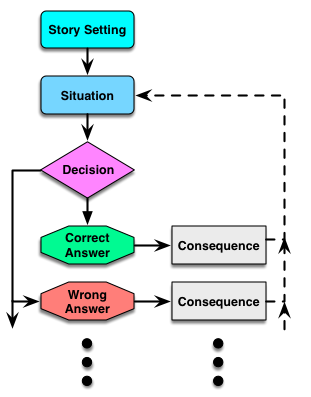Of late, a lot of my work has been designing learning design. Helping orgs transition their existing design processes to ones that will actually have an impact. That is, someone’s got a learning design process, but they want to improve it. One idea, of course, is to replace it with some validated design process. Another approach, much less disruptive, is to find opportunities to fine tune the design. The idea is to find the minimal set of changes that will yield the maximal benefit. So what are the likely inflection points? Where am I finding those spots for redesigning? It’s about good learning.
Starting at the top, one place where organizations go wrong right off the bat is the initial analysis for a course. There’s the ‘give us a course on this’, but even if there’s a decent analysis the process can go awry. Side-stepping the big issue of performance consulting (do a reality check: is this truly a case for a course), we get into working to create the objectives. It’s about how you work with SMEs. Understanding what they can, and can’t, do well means you have the opportunity to ensure that you get the right objectives to design to.
From there, the most meaningful and valuable step is to focus on the practice. What are you having learners do, and how can you change that? Helping your designers switch to good assessment writing is going to be useful. It’s nuanced, so the questions don’t seem that different from typical ones, but they’re much more focused for success.
Of course, to support good application of the content to develop abilities, you need the right content! Again, getting designers to understand what the nuances of useful examples from just stories isn’t hard but rarely done. Similarly knowing why you want models and not just presentations about the concept isn’t fully realized.
Of course, making it an emotionally compelling experience has learning impact as well. Yet too often we see the elements just juxtaposed instead of integrated. There are systematic ways to align the engagement and the learning, but they’re not understood.
A final note is knowing when to have someone work alone, and when some collaboration will help. It’s not a lot, but unless it happens at the right time (or happens at all) can have a valuable contribution to the quality of the outcome.
I’ve provided many resources about better learning design, from my 7 step program white paper to my deeper elearning series for Learnnovators. And I’ve a white paper about redesigning as well. And, of course, if you’re interested in doing this organizationally, I’d welcome hearing from you!
One other resource will be my upcoming workshop at the Learning Solutions conference on March 25 in Orlando, where we’ll spend a day working on learning experience design, integrating engagement and learning science. Of course, you’ll be responsible for taking the learnings back to your learning process, but you’ll have the ammunition for redesigning. I’d welcome seeing you there!


